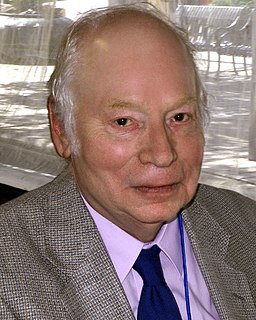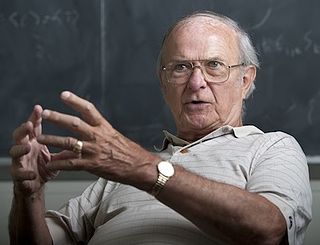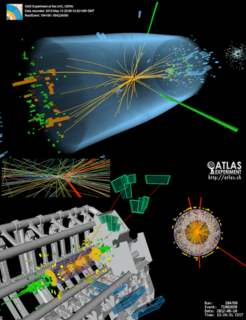
In particle physics, an elementary particle or fundamental particle is a subatomic particle that is not composed of other particles. Particles currently thought to be elementary include electrons, the fundamental fermions, as well as the fundamental bosons, which generally are force particles that mediate interactions among fermions. A particle containing two or more elementary particles is a composite particle.

Particle physics or high energy physics is the study of fundamental particles and forces that constitute matter and radiation. The fundamental particles in the universe are classified in the Standard Model as fermions and bosons. There are three generations of fermions, but ordinary matter is made only from the first fermion generation. The first generation consists of up and down quarks which form protons and neutrons, and electrons and electron neutrinos. The three fundamental interactions known to be mediated by bosons are electromagnetism, the weak interaction, and the strong interaction.

The Standard Model of particle physics is the theory describing three of the four known fundamental forces excluding gravity in the universe and classifying all known elementary particles. It was developed in stages throughout the latter half of the 20th century, through the work of many scientists worldwide, with the current formulation being finalized in the mid-1970s upon experimental confirmation of the existence of quarks. Since then, proof of the top quark (1995), the tau neutrino (2000), and the Higgs boson (2012) have added further credence to the Standard Model. In addition, the Standard Model has predicted various properties of weak neutral currents and the W and Z bosons with great accuracy.

Steven Weinberg was an American theoretical physicist and Nobel laureate in physics for his contributions with Abdus Salam and Sheldon Glashow to the unification of the weak force and electromagnetic interaction between elementary particles.

Peter Ware Higgs is a British theoretical physicist, Emeritus Professor in the University of Edinburgh, and Nobel Prize laureate for his work on the mass of subatomic particles.

Lisa Randall is an American theoretical physicist working in particle physics and cosmology. She is the Frank B. Baird, Jr. Professor of Science on the physics faculty of Harvard University. Her research includes the fundamental forces of nature and dimensions of space. She studies the Standard Model, supersymmetry, possible solutions to the hierarchy problem concerning the relative weakness of gravity, cosmology of dimensions, baryogenesis, cosmological inflation, and dark matter. She contributed to the Randall–Sundrum model, first published in 1999 with Raman Sundrum.

In quantum field theory, a false vacuum is a hypothetical vacuum that is relatively stable, but not in the most stable state possible. This condition is known as metastable. It may last for a very long time in that state, but could eventually decay to the more stable state, an event known as false vacuum decay. The most common suggestion of how such a decay might happen in our universe is called bubble nucleation – if a small region of the universe by chance reached a more stable vacuum, this "bubble" would spread.

Sir Thomas Walter Bannerman Kibble, was a British theoretical physicist, senior research investigator at the Blackett Laboratory and Emeritus Professor of Theoretical Physics at Imperial College London. His research interests were in quantum field theory, especially the interface between high-energy particle physics and cosmology. He is best known as one of the first to describe the Higgs mechanism, and for his research on topological defects. From the 1950s he was concerned about the nuclear arms race and from 1970 took leading roles in promoting the social responsibility of the scientist.

Sean Michael Carroll is an American theoretical physicist and philosopher who specializes in quantum mechanics, gravity, and cosmology. He is (formerly) a research professor in the Walter Burke Institute for Theoretical Physics in the California Institute of Technology (Caltech) Department of Physics and an External Professor at the Santa Fe Institute. He is currently Homewood Professor of Natural Philosophy at Johns Hopkins University in Baltimore from the summer of 2022. He has been a contributor to the physics blog Cosmic Variance, and has published in scientific journals such as Nature as well as other publications, including The New York Times, Sky & Telescope and New Scientist. He is known for atheism, critique of theism and defense of naturalism. He is considered a prolific public speaker and science populariser. In 2007, Carroll was named NSF Distinguished Lecturer by the National Science Foundation.

François, Baron Englert is a Belgian theoretical physicist and 2013 Nobel prize laureate.

Carl Richard Hagen is a professor of particle physics at the University of Rochester. He is most noted for his contributions to the Standard Model and Symmetry breaking as well as the 1964 co-discovery of the Higgs mechanism and Higgs boson with Gerald Guralnik and Tom Kibble (GHK). As part of Physical Review Letters 50th anniversary celebration, the journal recognized this discovery as one of the milestone papers in PRL history. While widely considered to have authored the most complete of the early papers on the Higgs theory, GHK were controversially not included in the 2013 Nobel Prize in Physics.

The Higgs boson, sometimes called the Higgs particle, is an elementary particle in the Standard Model of particle physics produced by the quantum excitation of the Higgs field, one of the fields in particle physics theory. In the Standard Model, the Higgs particle is a massive scalar boson with zero spin, even (positive) parity, no electric charge, and no colour charge, that couples to mass. It is also very unstable, decaying into other particles almost immediately.
In particle physics, a boson ( ) is a subatomic particle whose spin quantum number has an integer value. Bosons form one of the two fundamental classes of subatomic particle, the other being fermions, which have odd half-integer spin. Every observed subatomic particle is either a boson or a fermion.

Fabiola Gianotti is an Italian experimental particle physicist who is the current and first woman Director-General at CERN in Switzerland. Her first mandate began on 1 January 2016 and ran for a period of five years. At its 195th Session in 2019, the CERN Council selected Gianotti for a second term as Director-General. Her second five-year term began on 1 January 2021 and goes on until 2025. This is the first time in CERN's history that a Director-General has been appointed for a full second term.

From Eternity to Here: The Quest for the Ultimate Theory of Time is a non-fiction book by American theoretical physicist Sean M. Carroll. The book was initially released on January 7, 2010 by Dutton.

The search for the Higgs boson was a 40-year effort by physicists to prove the existence or non-existence of the Higgs boson, first theorised in the 1960s. The Higgs boson was the last unobserved fundamental particle in the Standard Model of particle physics, and its discovery was described as being the "ultimate verification" of the Standard Model. In March 2013, the Higgs boson was officially confirmed to exist.

Sir Tejinder Singh Virdee,, is a Kenyan-born British experimental particle physicist and Professor of Physics at Imperial College London. He is best known for originating the concept of the Compact Muon Solenoid (CMS) with a few other colleagues and has been referred to as one of the 'founding fathers' of the project. CMS is a world-wide collaboration which started in 1991 and now has over 3500 participants from 45 countries.

Sau Lan Wu is a Chinese American particle physicist and the Enrico Fermi Distinguished Professor of Physics at the University of Wisconsin-Madison. She made important contributions towards the discovery of the J/psi particle, which provided experimental evidence for the existence of the charm quark, and the gluon, the vector boson of the strong force in the Standard Model of physics. Recently, her team located at the European Organization for Nuclear Research (CERN), using data collected at the Large Hadron Collider (LHC), was part of the international effort in the discovery of a boson consistent with the Higgs boson.

Jeffrey Robert Forshaw is a British particle physicist with a special interest in quantum chromodynamics (QCD): the study of the behaviour of subatomic particles, using data from the HERA particle accelerator, Tevatron particle accelerator and the Large Hadron Collider (LHC) at CERN. Since 2004 he has been professor of particle physics in the School of Physics and Astronomy at the University of Manchester.

Cracking the Particle Code of the Universe: The Hunt for the Higgs Boson is a 2014 popular science book by Canadian physicist John Moffat. The first half of the book gives the reader an explanation of the particle physicists' Standard Model and the physical concepts associated with it, together with some possible alternatives to, and extensions of, the Standard Model. In the second half of the book, Moffat gives his personal account of how the discovery of the Higgs boson actually happened at the Large Hadron Collider (LHC). He writes about conferences he attended and interviews with some of the LHC physicists.
















